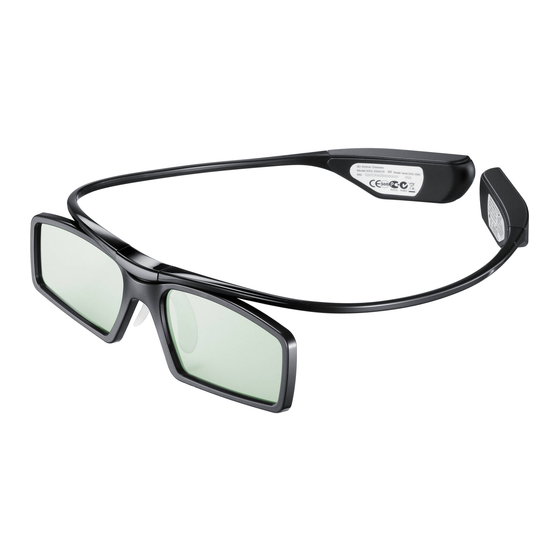
Advertisement
3D Active Glasses
SSG-3500CR
User's Guide
Features
Samsung's 3D glasses let you view 3D video and images on your compatble Samsung 3D TV. To
work, the glasses must be connected (paired) to the TV. The glasses connect to devices via the
2.4GHz RF band.
✎ The Samsung 3D glasses cannot connect to a non-Samsung wireless communication
device.
✎ 3D glasses can only connect to a Samsung 3D TV (D Series) released after 2011.
Parts
Nose pad
Liquid-crystal shutter
pairing button
✎ To wear the 3D glasses over eyeglasses, detach the nose pad from the 3D
glasses.
✎ Refer to the last chapter in this user guide for details about how to attach or
detach the nose pad.
01.eng.indd 1
Performing 3D Active Glasses pairing
✎ What is Pairing? Pairing is a process that prepares devices to exchange data so that, in
operation, the devices can transmit and exchange data instantly.
Pairing: Press the pairing button on the
3D glasses for more than 2 seconds.
Pairing will start.
Turning the glasses on and dff: Put on the
Components
3D glasses. The glasses will automatically
power on and the green LED will be lit for
● 3D Active Glasses
3 seconds. To power off the glasses, take
off the glasses. Several minutes later, the
glasses will automatically power off and
● User guide
the red LED will be lit for 3 seconds.
● Cleaning cloth
✎ Ensure your Samsung TV and 3D glasses are no farther than 50 cm (19.5 in) apart
from each another while pairing is in progress.
● Micro USB Cable
✎ The working distance depends on obstacles (a person, metal, walls, etc.) or
electromagnetic waves.
✎ Note that if you take off the 3D glasses while viewing 3D video and the 3D mode remains
● Nose pad
enabled on your TV, it will take 5 minutes for the 3D glasses to power off.
✎ If the glasses do not operate immediately when you put them on while the TV is in 3D
mode, lightly tap the "sensor pad" on the glasses.
✎ This product is rechargeable. It may not operate due to the dead battery when you
attempt to use it for the first time. In this case, charge the battery.
‹ Operating range
Recommended pairing distance
50cm
2~6m
Recommended viewing distance
Recommended
2~6m (6 to 19.5 ft)
viewing distance
Recommended
50cm (19.5 in)
pairing distance
English-1
2011-03-28 오전 9:23:03
Advertisement
Table of Contents

Summary of Contents for Samsung SSG-3500CR
- Page 1 User’s Guide Recommended pairing distance Features Samsung’s 3D glasses let you view 3D video and images on your compatble Samsung 3D TV. To 50cm work, the glasses must be connected (paired) to the TV. The glasses connect to devices via the 2~6m 2.4GHz RF band.
- Page 2 – Pairing may be needed again after you have had your 3D TV repaired. ※ If so, dim the light or turn the lamp off. – You want to view a 3D video on a different Samsung 3D TV released in 2011 or after.
-
Page 3: Safety Precautions
• The vividness of the image may appear degraded if you view 3D video in CAUTION a place that is exposed to direct sunlight or illumination. IMPORTANT HEALTH AND SAFETY INFORMATION FOR 3D IMAGES. READ • If you lie on your side while watching TV with 3D glasses, the picture may THE FOLLOWING CAUTIONS BEFORE YOU OR YOUR CHILD USE THE 3D look dark or may not be visible. -
Page 4: Specifications
• Do not sleep with the 3D glasses on. The arms on the glasses may become when On broken. Operating • Make sure to use only 3D glasses that are authorized and supplied by Samsung 32°F to 104°F (0°C to 40°C) Electronics. Temperature... -
Page 5: Procedure For Making A Warranty Claim
7. NOTHING IN THESE WARRANTY CONDITIONS SHALL EXCLUDE OR LIMIT • a copy of your completed warranty card or, if you have already provided this to Samsung, your SAMSUNG’S LIABILITY FOR DEATH OR PERSONAL INJURY CAUSED BY THE name, address and contact telephone number;... - Page 6 Regulatory Compliance Statements ‹ IC Statement This Class B digital apparatus complies with Canadian ICES-003. ‹ NCC Taiwan Operation is subject to the following two conditions: (1) this device may not cause interference, and (2) this device must accept any interference, including interference that may cause undesired operation of the device. 低功率電波輻射性電機管理辦法...















